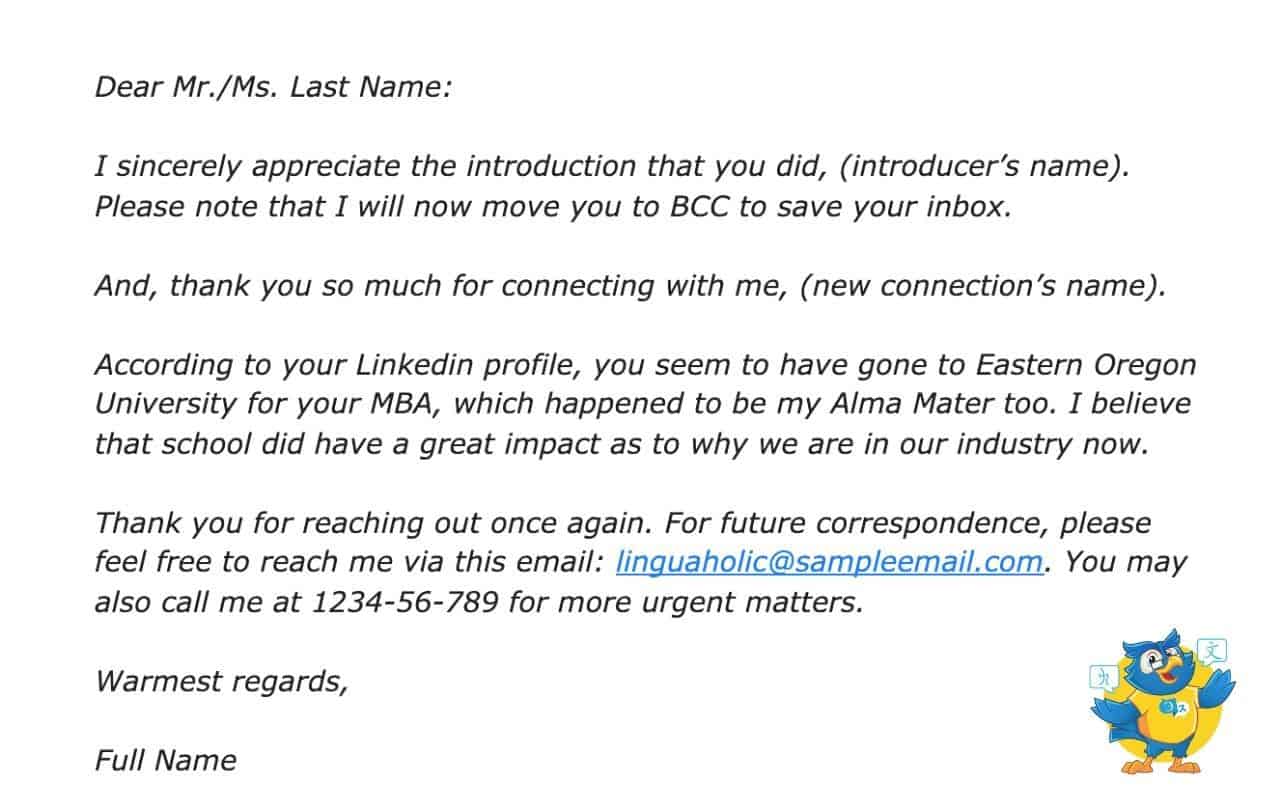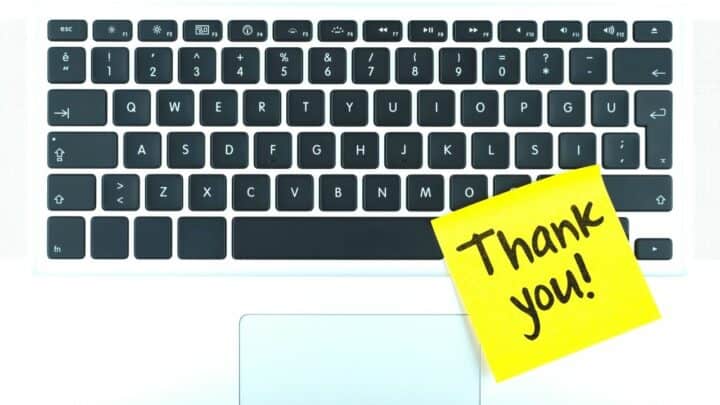You don’t have to be a playwright to write effectively – that’s what you have to keep telling yourself. Every day.
Of course, nobody gets better in writing with less practice, not to mention reading, so landing on our humble page is already a good start.
Interestingly enough, people have been concerned as to how to write a possible response to referral messages; in other words, when a person introduces you to their connection.
Let’s take a stroll through some easy guidelines to follow to make your introduction email response look like a pro. (Bonus tips are also available later.)
How can we write a thank-you reply to an introduction email?
To reply to an introduction email, we have to use the introduction-body-conclusion format in a concise, accommodating, and engaging way. It is also advisable to send a courtesy copy or blind courtesy copy to the introducer or initiator during this kind of correspondence.
Formatting your letter
No matter what kind of correspondence you do, structuring your message always needs to follow a basic writing structure.
Just like how architects design houses, writing, per se, essentializes three basic elements that should always be followed: an introduction, a body, and a conclusion.
And, everything that goes into each of these parts should be crafted in such a way that it conveys the writer’s persuasive language use.
One of the deepest secrets of writing an engaging text simply lies in the act of making the message more about the addressee, rather than the self.
In other words, the message creator must avoid talking excessively about himself; not unless there is anything specific that has to be addressed accordingly.
Again, the key to making your writing as effective as a playwright’s work is to simply make the other party feel important and appreciated.
This is often demonstrated through our use of expressions like “a huge thank you” in casual scenarios, which may also be formalized by saying something like “thank you for your kind words.”
So, what do I exactly mean by this act of appreciation? We had better go through each specific part in detail to really get the hang of what I’m pointing at.
Introduction: Gratitude
The introduction is ideally composed of a gratitude message intended for the recipient, as well as to the person who made the introduction happen.
Expressing gratitude is an extremely powerful tool that holds society together, and hence, learning different ways to say thank you in the business world could be an advantage.
Since you’re straightforwardly replying to the new connection, you can just use the “BCC” function to alert the introducer that you are already “getting in touch” with the other person.
“BCC” stands for “blind carbon/courtesy copy,” a function that allows an email user to send a duplicate email to another recipient confidentially.
Whereas, “carbon copy” or “cc,” a term often associated with “cc’ed” and “copy”, is another option that allows both primary and secondary recipients to receive and get notified about an email.
If you wish to use either the “BCC” or “CC” option, an introductory gratitude message for both recipients may look like the following:
Example 1 (using BCC)
Example 2 (using CC)
Please note that I will now move you to BCC to save your inbox. And, thank you so much for connecting with me, (new connection’s name).
When going for the “BCC” option, it might be redundant to explicitly express gratitude to the person for being bcc’ed because, again, this email function is expected to be undisclosed.
However, when selecting to cc the introducer, which means that both parties can actually see any tagged recipients, then it is ethical to recognize the person being cc’ed.
An alternative option would be to cc the introducer during the first email exchange, and then move him or her to BCC afterward.
This would serve as a blanket of assurance that nothing goes wrong in your future conversations with your new connection, especially if he or she is someone whom your introducer thinks highly of.
Body Text
Now, we go to the meat of the email message or the “body.” The content of this part should be dependent on the implied purpose of the email you received.
An email introduction may occur because you could become a prospective employee, product/service provider, client, informational reference, or even just a cold connection to another person.
If the introducer is good enough, he or she would provide an initial context to both parties in the original email or discussion with the other party.
But, to contextualize this idea even better, let’s just say that you have been introduced as a potential service provider.
This means that the person you’re about to correspond with automatically becomes your potential client, and hence, the need to be as accommodating as possible.
This situation could also suggest that your introducer may have already provided initial information regarding the service that you offer, or at least, the type of industry where you belong.
One of the best entrepreneurial practices is to recommend a brief call or meeting with the other party so that you can have enough time to pitch your product or service.
When this happens, the body of your email may contain the following lines:
Example 1:
Yes, Sir. You got the right information that I work for a company offering cost-reduction services. Most of our clients belong to your kind of industry too, so perhaps we can discuss this matter through a 15-minute call in the future.
You may refer to the link attached below for my schedule availability. I am also free between 2-4 pm today, should you also have the time for a quick discussion.
If the email you received is not related to any business potential at the moment, for instance, it may just be an attempt to establish rapport for connection purposes, then you can just respond warmly to the person.
To do this, you can do a bit of research about the new connection, as this will allow you to find a common ground that you can use during the correspondence.
Navigating through their Linkedin profile, without adding them yet, is a recommended step to take.
Please bear in mind not to use their personal social media accounts like Facebook or Instagram as your main references so as not to be perceived as “intrusive.”
However, you may reference their “company pages” on the mentioned platforms instead, should they do not have an account on Linkedin.
Example 2:
Conclusion
Lastly, any kind of formal correspondence should ideally end with a professional and positive note.
For seasoned individuals, ending an email should be as easy as shooting fish in a barrel, however, for some, this might still be a bit of a challenge.
There are also some guidelines about how to end an email professionally that one can refer to and follow, which is another common writing concern at present.
To conclude an introduction email reply or response, one has to particularly include a goodwill note, as well as other relevant contact details that could help the addressee in the future.
Your conclusion may be stated along the lines of the following statements.
Example 1:
Example 2:
Sample reply to an introduction via email
Writing a formal email entails the need to use salutations, which we may want to vary from time to time.
For more salutation options, you may also want to check out our other resource on Dear Sir or Madam Alternatives.

As you may have noticed, the complimentary close “warmest regards” conveys a personal tone that aims to accommodate the recipient of the message.
In the context of the example given, using a personal yet still professional tonality could be tantamount to a prospective business discussion, which is why it is crucial.
The four Be’s & P’s when writing a thank you letter for an introduction email: Bonus Tips
Now that we’ve covered every nook and cranny of writing a reply to an introduction email, here are bonus tips to make your email even more powerful than Thor.
Be prompt
In the commercial world, time actually means money most of the time, and therefore, replying promptly should do more good than harm.
An ideal email response should be received by the target recipient within twenty-four hours, as emailing systems aren’t designed like direct messaging platforms.
Apparently, this doesn’t mean that you would come across as rude if you respond a couple of days later due to some valid reason. But then, again, the earlier the better.
Be polite
Any formal correspondence should be conveyed with a polite tone due to the absence of the writer’s voice and facial expressions.
The world of writing is rather tricky simply because interpretation is more relative to the reader rather than the writer’s perspective.
This is also especially true because we are talking about “initial contact” in our article today.
Be positive
Thirdly, a positive tonality should always be observed as well, which does not necessarily mean that you should pepper your email with flowery words.
Being positive simply means deliberately avoiding words and sentences containing negative connotations.
This is recommended because you would never want to evoke anything that could be misinterpreted by the message receiver.
Be a pedant (for grammar)
Last but not least, use all your possible tools or time to proofread your email message, as not to create a “tactless” impression toward the addressee.
Of course, typographical errors could be easily and immediately spotted by a keen observer, which is a natural, acceptable phenomenon.
But, consistent grammatical issues may raise a communicative concern to your target audience, which could have a negative impact on yourself as well as the organization you’re connected with.
Installing free grammar-checker tools could also save you from these writing mishaps.
Frequently Asked Questions on “How to write a thank you letter reply
for an introduction email”
How can we respond when someone introduces themselves?
It is always ideal to start by expressing gratitude toward the act of introduction, followed by initiating to talk about a common interest that may exist between the interlocutors.
What is a synonym for “thanks for the great introduction”?
“I sincerely appreciate the introduction” is a formal synonym, while “Thanks for connecting us” is a relatively less formal alternative.
What does “thank you for connecting me with someone” mean?
“Thank you for connecting me with someone” is a message that is used to express gratitude when referrals take place. It is conveyed towards the introducer or initiator of the two people who were connected.
Conclusion
Referrals or recommendations are actually what every entrepreneur wants because, if done appropriately, they do not have to go through the taxing process of cold prospecting anymore.
This is especially critical because one needs to establish a reliable and likable persona or brand first before referrals take place, which typically takes a while.
So, never forget to also find possible ways to leverage the network of any person who has given you the favor of an introduction or recommendation to others.

Hey fellow Linguaholics! It’s me, Marcel. I am the proud owner of linguaholic.com. Languages have always been my passion and I have studied Linguistics, Computational Linguistics and Sinology at the University of Zurich. It is my utmost pleasure to share with all of you guys what I know about languages and linguistics in general.

